Fabrication of a Gd2O3-Based Film to Shield from Space Radiation inside Aircraft and Its Effectiveness
Abstract
:1. Introduction
2. Materials and Methods
2.1. Production of the Shielding Film
2.2. Dose Evaluation Algorithm
2.3. Space-Radiation Measuring Instrument
2.4. Detector Calibration Test
3. Results
3.1. Observation Results of the Internal Cross-Section of the Shielding Film
3.2. Flight Test Route and Korean Radiation Exposure Assessment Model for Aviation Route Dose (KREAM): Estimated Dose Rate
3.3. Demonstration Test of the Space-Radiation Shielding Sheet using a Silicon Detector
4. Discussion
5. Conclusions
Author Contributions
Funding
Data Availability Statement
Conflicts of Interest
References
- Yang, D.; Bayazitoglu, Y. Polymer composites as radiation shield against galactic cosmic rays. J. Thermophys. Heat Transf. 2020, 34, 457–464. [Google Scholar] [CrossRef]
- Sato, T.; Kataoka, R.; Shiota, D.; Kubo, Y.; Ishii, M.; Yasuda, H.; Miyake, S.; Miyoshi, Y.; Ueno, H.; Nagamatsu, A. Nowcast and forecast of galactic cosmic ray (GCR) and solar energetic particle (SEP) fluxes in magnetosphere and ionosphere–extension of WASAVIES to Earth orbit. J. Space Weather Space Clim. 2019, 9, A10. [Google Scholar] [CrossRef]
- Klein, E.M.; Sznajder, M.; Seefeldt, P. Proton Spectra for the Interplanetary Space Derived From Different Environmental Models. Front. Space Technol. 2022, 3, 933340. [Google Scholar] [CrossRef]
- Tobiska, W.K.; Atwell, W.; Beck, P.; Benton, E.; Copeland, K.; Dyer, C.; Gersey, B.; Getley, I.; Hands, A.; Holland, M.; et al. Advances in atmospheric radiation measurements and modeling needed to improve air safety. Space Weather 2015, 13, 202–210. [Google Scholar] [CrossRef]
- Jang, R.J. Literature review on cosmic radiation exposure to air craft cabin crew. J. Radiol. Sci. Technol. 2018, 41, 643–649. [Google Scholar] [CrossRef]
- Sihver, L.; Kodaira, S.; Ambrožová, I.; Uchihori, Y.; Shurshakov, V. Radiation Environment Onboard Spacecraft at LEO and in Deep Space. In Proceedings of the 2016 IEEE Aerospace Conference, Big Sky, MT, USA, 1–9 March 2016. [Google Scholar] [CrossRef]
- Bilski, P.; Olko, P.; Horwacik, T. Air-crew exposure to cosmic radiation on board of Polish passenger aircraft. Nukleonika 2004, 49, 77–83. [Google Scholar]
- Dobynde, M.I.; Svertilov, S.I.; Panasyuk, M.I. Calculating the radiation dose rates created by cosmic rays in the Earth’s atmosphere. Bull. Russ. Acad. Sci. Phys. 2021, 85, 1302–1305. [Google Scholar] [CrossRef]
- Mendes, M.M.; Darling, A.L.; Hart, K.H.; Morse, S.; Murphy, R.J.; Lanham-New, S.A. Impact of high latitude, urban living and ethnicity on 25-hydroxyvitamin D status: A need for multidisciplinary action? J. Steroid Biochem. Mol. Biol. 2019, 188, 95–102. [Google Scholar] [CrossRef]
- Kim, S.C.; Son, J.S. Double-layered fiber for lightweight flexible clothing providing shielding from low-dose natural radiation. Sci. Rep. 2021, 11, 3676. [Google Scholar] [CrossRef]
- Hou, J.; Park, C.; Jang, W.; Byun, H. Facile fabrication and characterization of aliphatic polyketone (PK) micro/nano fiber membranes via electrospinning and a post treatment process. RSC Adv. 2021, 11, 678–683. [Google Scholar] [CrossRef]
- Yun, J.; Hou, J.; Jang, W.; Kim, S.Y.; Byun, H. Electrospun tungsten-polyurethane composite nanofiber mats for medical radiation-shielding applications. ChemNanoMat 2022, 8, e202100387. [Google Scholar] [CrossRef]
- Liang, X.; Gao, G.; Wu, G. Statistical analysis on hollow and core-shell structured vanadium oxide microspheres as cathode materials for Lithium ion batteries. Data Brief 2018, 18, 719–722. [Google Scholar] [CrossRef]
- Dietze, G.; Bartlett, D.T.; Cool, D.A.; Cucinotta, F.A.; Jia, X.; McAulay, I.R.; Pelliccioni, M.; Petrov, V.; Reitz, G.; Sato, T. ICRP PUBLICATION 123: Assessment of Radiation Exposure of Astronauts in Space. Ann. ICRP 2013, 42, 1–339. [Google Scholar] [CrossRef]
- Schwadron, N.A.; Rahmanifard, F.; Wilson, J.; Jordan, A.P.; Spence, H.E.; Joyce, C.J.; Zeitlin, C. Update on the worsening particle radiation environment observed by CRaTER and implications for future human deep-space exploration. Space Weather 2018, 16, 289–303. [Google Scholar] [CrossRef]
- Paek, S.W.; Balasubramanian, S.; Stupples, D. Composites Additive Manufacturing for Space Applications: A Review. Materials 2022, 15, 4709. [Google Scholar] [CrossRef]
- Miroshnichenko, L.I. Radiation Conditions in Space. In Radiation Hazard in Space. In Astrophysics and Space Science Library; Springer: Dordrecht, The Netherlands, 2003; p. 297. [Google Scholar] [CrossRef]
- Semwal, M.K. International Commission on Radiological Protection Report 152(2022): Radiation detriment calculation methodology. J. Med. Phys. 2023, 48, 98–99. [Google Scholar] [CrossRef]
- Hess, W.N.; Patterson, H.W.; Wallace, R.; Chupp, E.L. Cosmic-ray neutron energy spectrum. Phys. Rev. 1959, 116, 445–457. [Google Scholar] [CrossRef]
- Khong, J.C.; Daisenberger, D.; Burca, G.; Kockelmann, W.; Tremsin, A.S.; Mi, J. Design and characterization of metallic glassy alloys of high neutron shielding capability. Sci. Rep. 2016, 6, 36998. [Google Scholar] [CrossRef]
- Hwang, J.A.; Kwak, J.Y.; Jo, G.B.; Nam, U.W. Validation of KREAM based on in-situ measurements of aviation radiation in commercial flights. J. Astron. Space Sci. 2020, 37, 229–236. [Google Scholar] [CrossRef]
- Osunwusi, A.O. Occupational radiation exposures in aviation: Air traffic safety systems considerations. Int. J. Aviat. Aeronaut. Aerosp. 2020, 7, 6. [Google Scholar] [CrossRef]
- Spence, H.E.; Case, A.W.; Golightly, M.J.; Heine, T.; Larsen, B.A.; Blake, J.B.; Caranza, P.; Crain, W.R.; George, J.; Lalic, M.; et al. CRaTER: The cosmic ray telescope for the effects of radiation experiment on the lunar reconnaissance orbiter mission. Space Sci. Rev. 2010, 150, 243–284. [Google Scholar] [CrossRef]
- Loffredo, F.; Vardaci, E.; Pugliese, M.; Serra, M.; Quarto, M. Dosimetry in Space: The shielding effectiveness for the radioprotection of astronauts against 1 GeV protons. IL Nuovo Cimento C 2020, 43, 133. [Google Scholar] [CrossRef]
- Kobayashi, M.; Ieiri, M.; Kondo, K.; Miura, T.; Noumi, H.; Numajiri, M.; Oki, Y.; Suzuki, T.; Takasaki, M.; Tanaka, K.; et al. Radiation hardness of cerium-doped gadolinium silicate Gd2SiO5:Ce against high energy protons, fast and thermal neutrons. Nucl. Instrum. Methods Phys. Res. Sect. A Accel. Spectrometers Detect. Assoc. Equip. 1993, 330, 115–120. [Google Scholar] [CrossRef]
- Cheewasukhanont, W.; Limkitjaroenporn, P.; Sayyed, M.I.; Kothan, S.; Kim, H.J.; Kaewkhao, J. High density of tungsten gadolinium borate glasses for radiation shielding material: Effect of WO3 concentration. Radiat. Phys. Chem. 2022, 192, 109926. [Google Scholar] [CrossRef]
- Azman, M.N.; Abualroos, N.J.; Yaacob, K.A.; Zainon, R. Feasibility of nanomaterial tungsten carbide as lead-free nanomaterial-based radiation shielding. Radiat. Phys. Chem. 2023, 202, 110492. [Google Scholar] [CrossRef]
- Sato, T. Recent progress in space weather research for cosmic radiation dosimetry. Ann. ICRP 2020, 49 (Suppl. S1), 185–192. [Google Scholar] [CrossRef]
- Yasuda, H.; Kurita, N.; Yajima, K. Verification of estimated cosmic neutron intensities using a portable neutron monitoring system in Antarctica. Appl. Sci. 2023, 13, 3297. [Google Scholar] [CrossRef]
- Dumazert, J.; Coulon, R.; Lecomte, Q.; Bertrand, G.H.V.; Hamel, M. Gadolinium for neutron detection in current nuclear instrumentation research: A review. Nucl. Instrum. Methods Phys. Res. Sect. A Accel. Spectrometers Detect. Assoc. Equip. 2018, 882, 53–68. [Google Scholar] [CrossRef]
- Chang, Q.; Guo, S.; Zhang, X. Radiation shielding polymer composites: Ray-interaction mechanism, structural design, manufacture and biomedical applications. Mater. Des. 2023, 233, 112253. [Google Scholar] [CrossRef]
- Kim, S.C. Analysis of shielding performance of radiation-shielding materials according to particle size and clustering effects. Appl. Sci. 2021, 11, 4010. [Google Scholar] [CrossRef]
- Shreef, A.M.; Abdulzahara, N.A. Manufacture of shielding for attenuation ionization ray by the preparation of nano gadolinium oxide with PMMA. NeuroQuantology 2021, 19, 66. [Google Scholar] [CrossRef]
- Zhang, P.; Jia, C.; Li, J.; Wang, W. Shielding composites for neutron and gamma-radiation with Gd2O3@W core-shell structured particles. Mater. Lett. 2020, 276, 128082. [Google Scholar] [CrossRef]
- Hannachi, E.; Sayyed, M.I.; Slimani, Y.; Elsafi, M. Structural, optical and radiation shielding peculiarities of strontium titanate ceramics mixed with tungsten nanowires: An experimental study. Opt. Mater. 2023, 135, 113317. [Google Scholar] [CrossRef]
- Obaid, S.S.; Sayyed, M.I.; Gaikwad, D.K.; Pawar, P.P. Attenuation coefficients and exposure buildup factor of some rocks for gamma ray shielding applications. Radiat. Phys. Chem. 2018, 148, 86–94. [Google Scholar] [CrossRef]
- Poitrasson-Rivière, A.; Hamel, M.C.; Polack, J.K.; Flaska, M.; Clarke, S.D.; Pozzi, S.A. Dual-particle imaging system based on simultaneous detection of photon and neutron collision events. Nucl. Instrum. Methods Phys. Res. Sect. A Accel. Spectrometers Detect. Assoc. Equip. 2014, 760, 40–45. [Google Scholar] [CrossRef]
- Cole, J.M.; Behm, K.T.; Gerstmayr, E.; Blackburn, T.G.; Wood, J.C.; Baird, C.D.; Duff, M.J.; Harvey, C.; Ilderton, A.; Joglekar, A.S.; et al. Experimental evidence of radiation reaction in the collision of a high-intensity laser pulse with a laser-wakefield accelerated electron beam. Phys. Rev. X 2018, 8, 011020. [Google Scholar] [CrossRef]
- Blachowicz, T.; Ehrmann, A. Shielding of cosmic radiation by fibrous materials. Fibers 2021, 9, 60. [Google Scholar] [CrossRef]

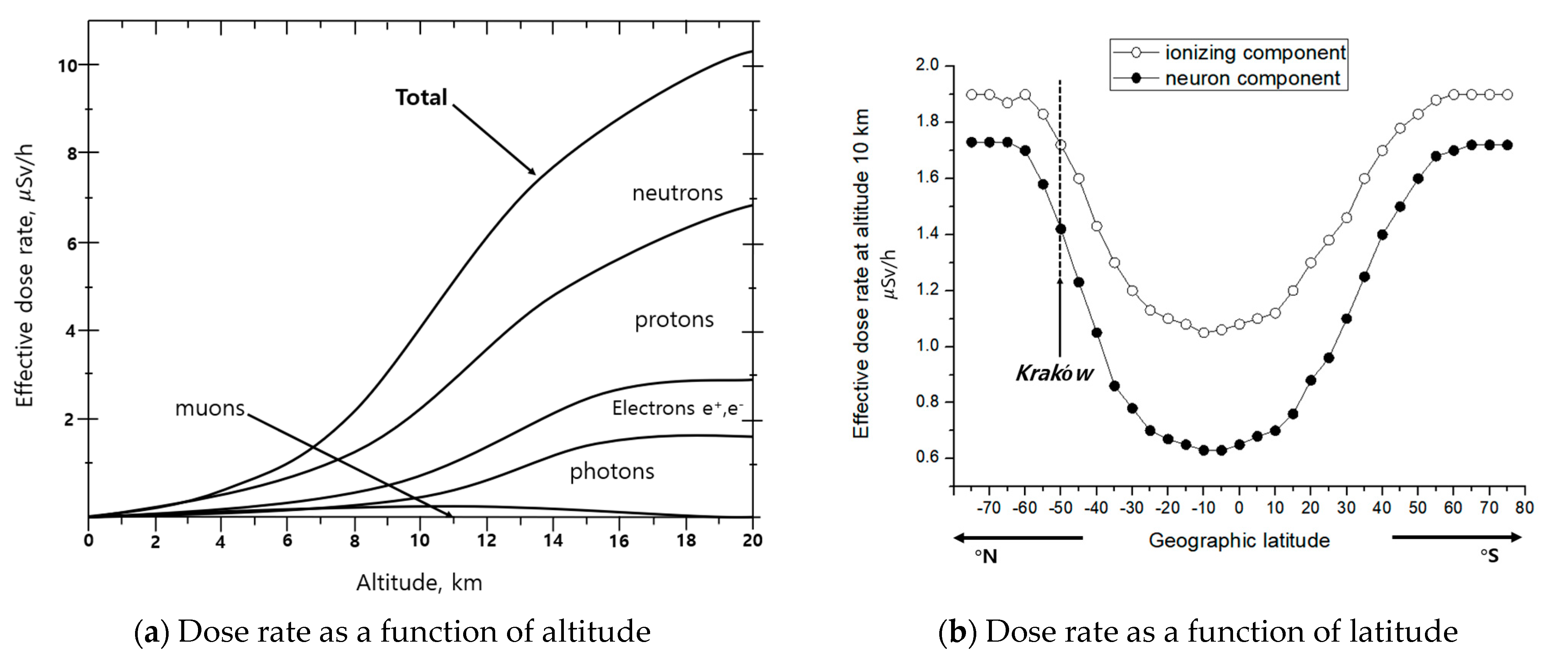



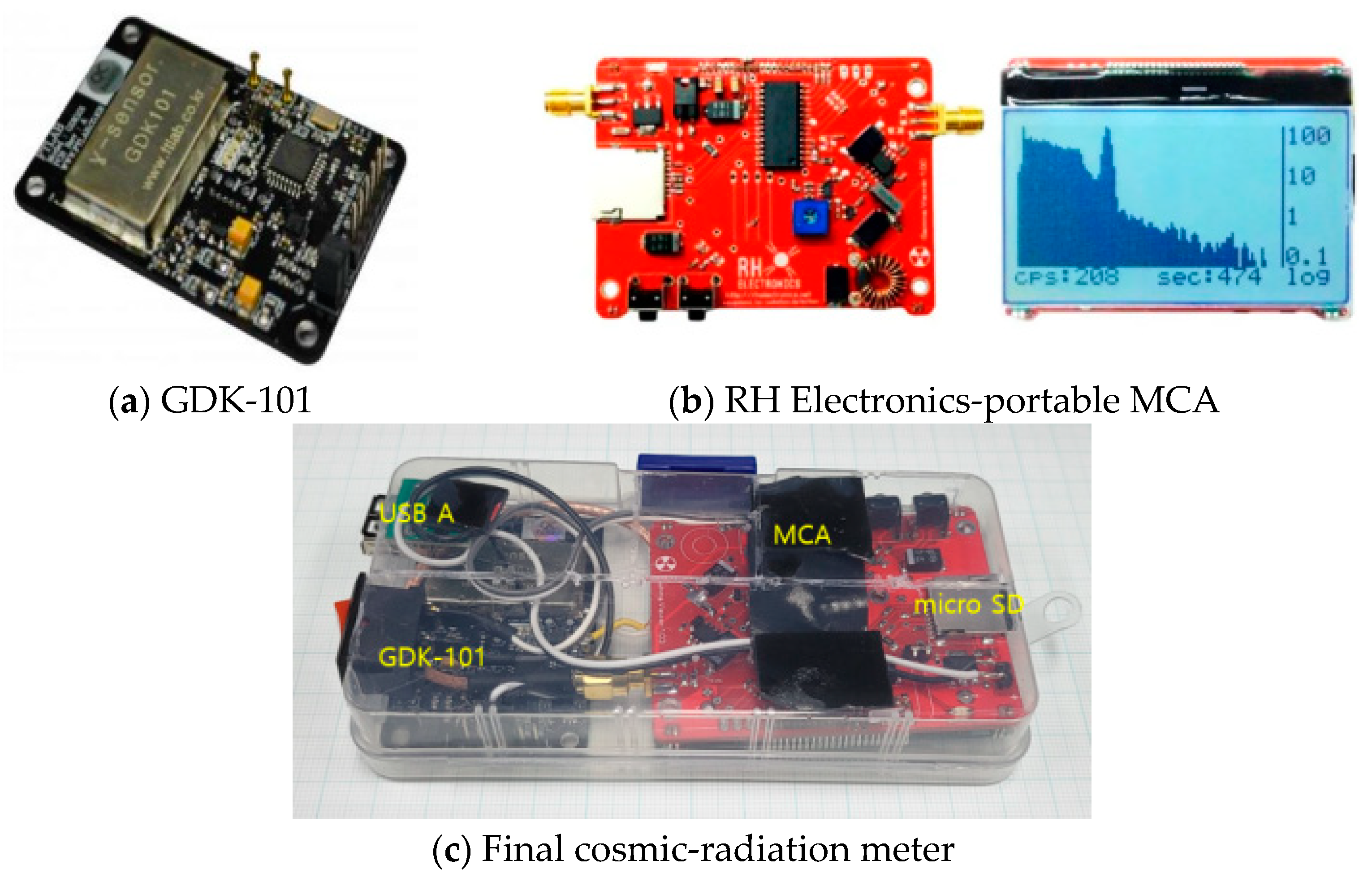
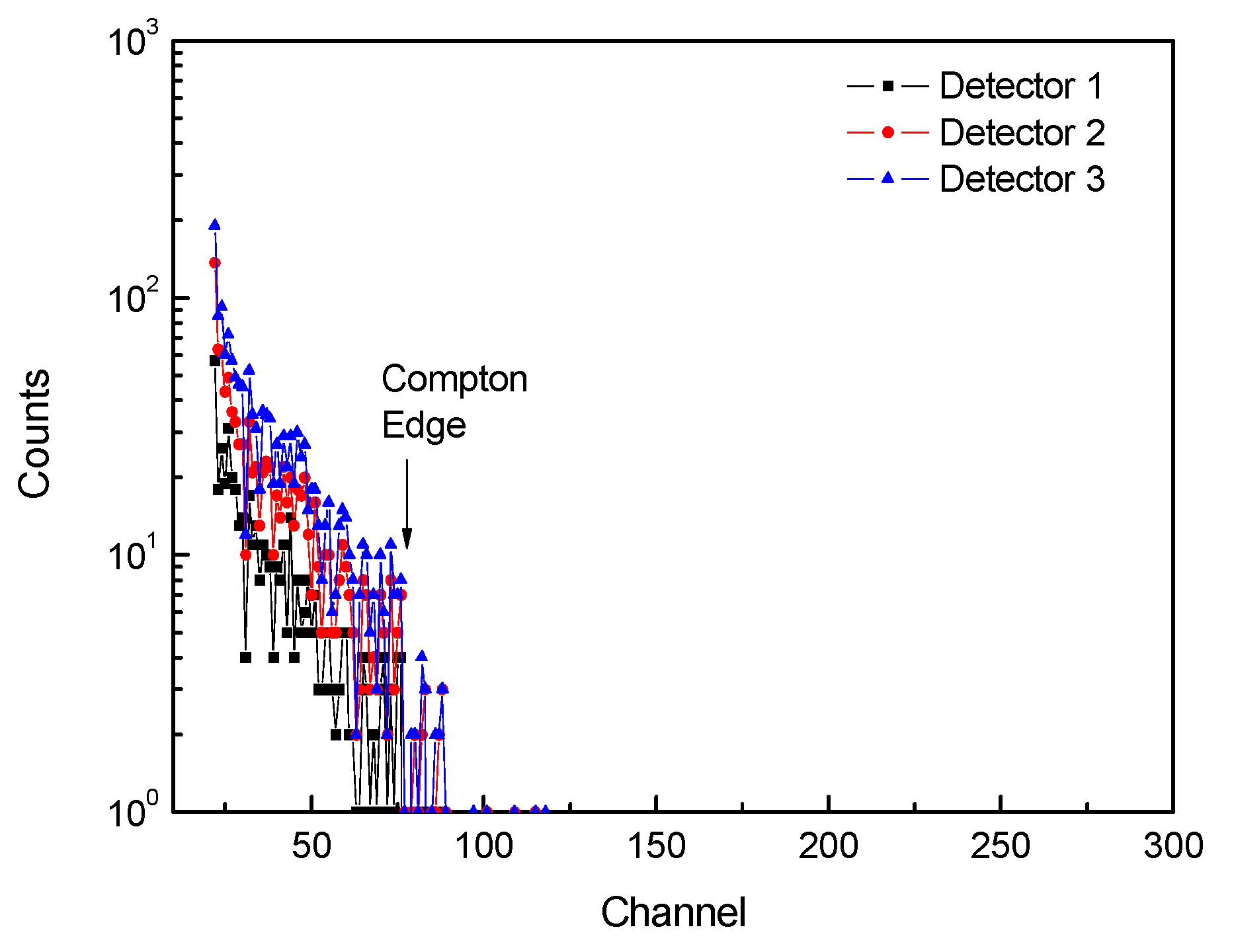



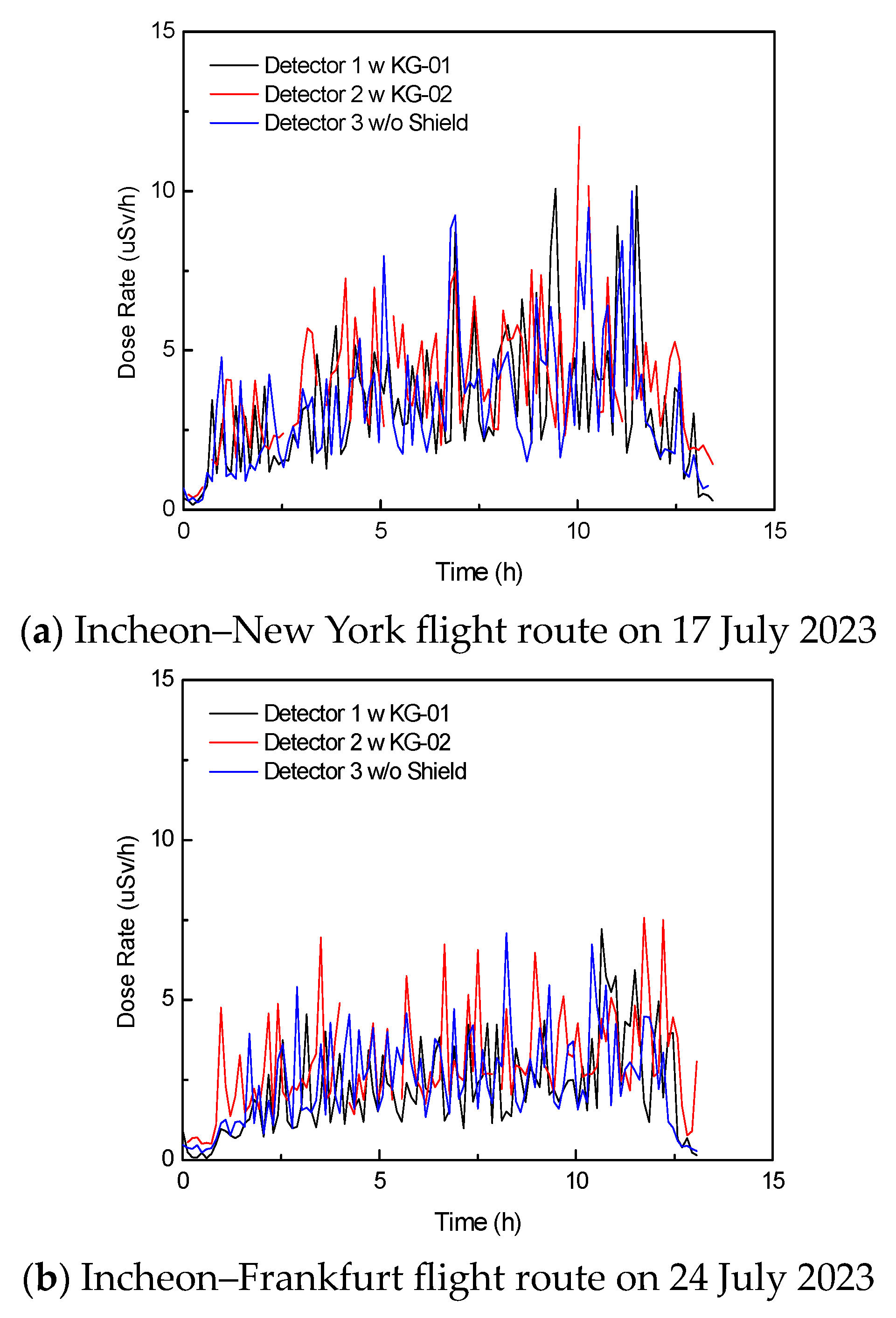
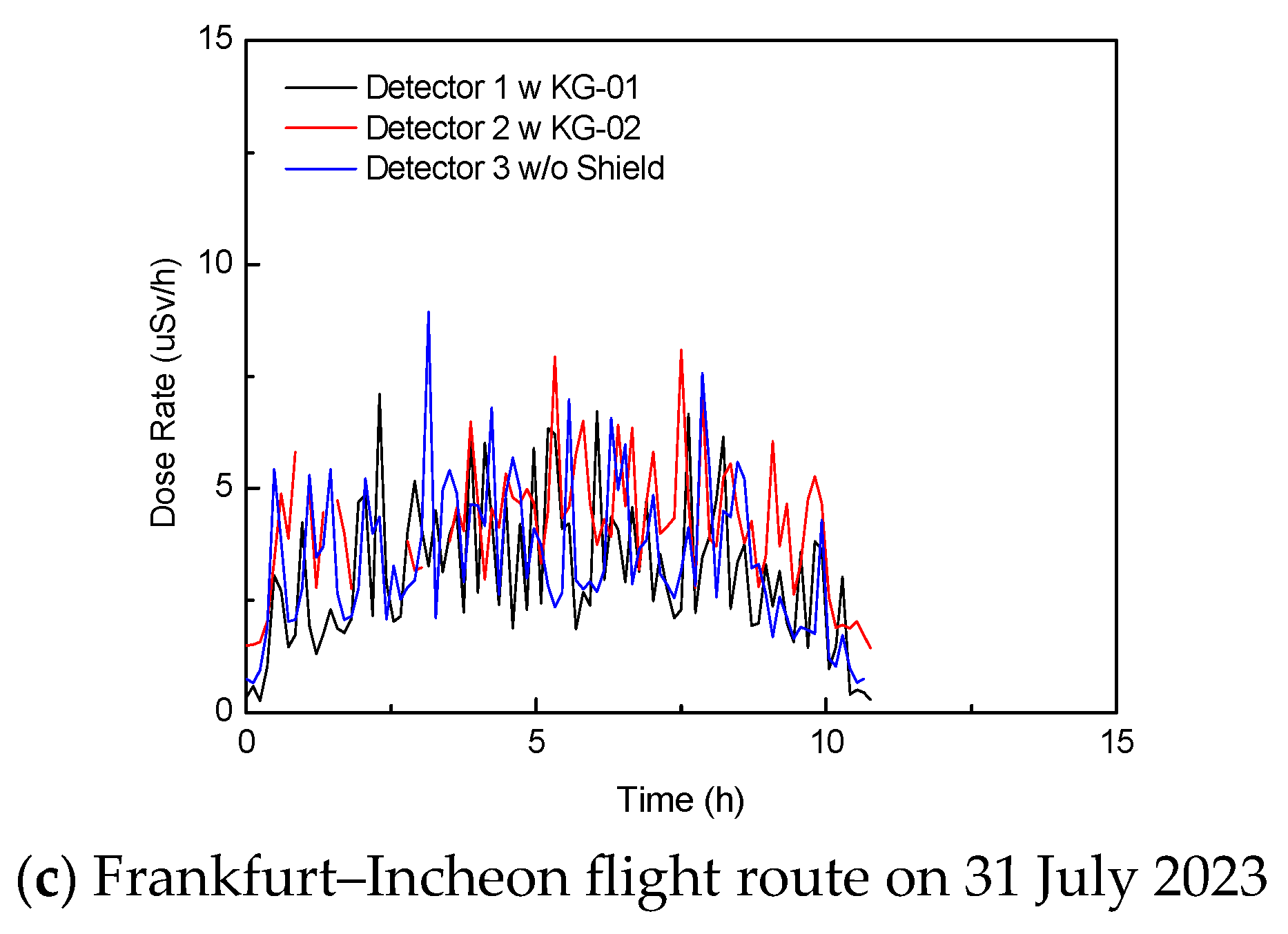


| Flight | Dose Rate (μSv/h) | |||
|---|---|---|---|---|
| Detector 1 with KG-01 | Detector 2 with KG-02 | Detector 3 without (w/o) Shield | KREAM | |
| 2023.07 ICN–JFK | 5.88 | 5.96 | 5.90 | 6.34 |
| 2023.07 ICN–FRK | 3.84 | 4.37 | 4.26 | 4.52 |
| 2023.07 FRK–ICN | 3.36 | 3.93 | 3.71 | 4.11 |
| Flight | Ratio of the Dose Rate | |
|---|---|---|
| 2023.07 ICN-JFK | 98.6 | 101.0 |
| 2023.07 ICN-FRK | 87.9 | 102.5 |
| 2023.07 FRK-ICN | 85.7 | 105.7 |
| Trans. AVG (%) | 90.7 ± 5.6 | 103.1 ± 2.0 |
| Shielding (%) | +9.3% | −3.1% |
Disclaimer/Publisher’s Note: The statements, opinions and data contained in all publications are solely those of the individual author(s) and contributor(s) and not of MDPI and/or the editor(s). MDPI and/or the editor(s) disclaim responsibility for any injury to people or property resulting from any ideas, methods, instructions or products referred to in the content. |
© 2023 by the authors. Licensee MDPI, Basel, Switzerland. This article is an open access article distributed under the terms and conditions of the Creative Commons Attribution (CC BY) license (https://creativecommons.org/licenses/by/4.0/).
Share and Cite
Kim, S.-C.; Kim, S.-H. Fabrication of a Gd2O3-Based Film to Shield from Space Radiation inside Aircraft and Its Effectiveness. Aerospace 2023, 10, 968. https://doi.org/10.3390/aerospace10110968
Kim S-C, Kim S-H. Fabrication of a Gd2O3-Based Film to Shield from Space Radiation inside Aircraft and Its Effectiveness. Aerospace. 2023; 10(11):968. https://doi.org/10.3390/aerospace10110968
Chicago/Turabian StyleKim, Seon-Chil, and Sung-Hwan Kim. 2023. "Fabrication of a Gd2O3-Based Film to Shield from Space Radiation inside Aircraft and Its Effectiveness" Aerospace 10, no. 11: 968. https://doi.org/10.3390/aerospace10110968





